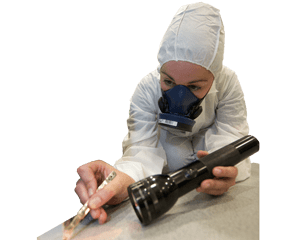Your Guide to Effective Asbestos Checking Procedures
Asbestos testing procedures are an essential element of ensuring the security of interior environments, particularly in older structures where this unsafe material may be existing. The possible health dangers connected with asbestos direct exposure make it crucial to come close to testing with precision and thoroughness.
Comprehending Asbestos and Its Threats
Asbestos, a normally occurring mineral known for its warm resistance and longevity, positions serious wellness threats when its fibers are inhaled or ingested. Asbestos testing near me. Exposure to asbestos can cause significant wellness problems such as lung mesothelioma, asbestosis, and cancer. Regardless of its beneficial residential properties, asbestos has actually been extensively outlawed in lots of countries because of the tested link between asbestos exposure and these life-threatening conditions
The threat hinges on the microscopic fibers that can easily come to be air-borne when asbestos-containing materials are disturbed or harmed. Once breathed in, these fibers can end up being lodged in the lungs, causing inflammation and scarring with time. The latency duration between direct exposure to asbestos and the advancement of associated diseases can extend numerous decades, making very early discovery and prevention crucial.
Asbestos was commonly made use of in building materials, insulation, and auto components before its health threats were completely understood. Today, correct screening and removal of asbestos-containing products are vital to protect people from the risks connected with asbestos exposure.
Identifying Possible Asbestos Materials
The recognition of prospective asbestos materials is an essential step in making sure the safety of individuals revealed to hazardous compounds in numerous environments. Asbestos can be discovered in a wide variety of building products, consisting of yet not limited to insulation, ceiling tiles, floor tiles, concrete sheets, and roof tiles - Asbestos Air Sampling. Determining these materials accurately is necessary to successfully handling the risks connected with asbestos direct exposure

In instances where visual examination is inconclusive, examples of suspected materials can be accumulated and sent to approved laboratories for screening. These research laboratories employ specialized methods such as polarized light microscopy or transmission electron microscopy to accurately identify the visibility of asbestos fibers in the samples. By complying with strenuous identification procedures, people can effectively reduce the threats associated with asbestos direct exposure.
Choosing the Right Testing Approach
Identification of prospective asbestos products plays a critical duty in establishing the suitable screening technique for accurate asbestos fiber discovery. As soon as suspected materials have actually been recognized, picking the right testing technique is necessary to guarantee trustworthy outcomes. There are 2 key methods for asbestos testing: polarized light microscopy (PLM) and transmission electron microscopy (TEM) PLM is typically utilized for preliminary testing as it is economical and gives fast outcomes. Nonetheless, PLM has constraints in spotting asbestos fibers that are smaller than 1 to 3 microns. On the other hand, TEM is an advanced method that can accurately identify asbestos fibers at the ultrastructural level. While more helpful hints TEM is more expensive and taxing than PLM, it supplies greater sensitivity and specificity in asbestos detection. Picking the ideal screening approach relies on numerous elements such as the sort of material being tested, the called for level of sensitivity of the evaluation, and the offered budget. It is crucial to talk to approved asbestos screening professionals to determine one of the most appropriate approach for your particular screening requirements.
Carrying Out Sample Collection Safely
When accumulating samples for asbestos testing, focusing on security measures is vital to minimize prospective direct exposure risks. Asbestos fibers are unsafe when disturbed, making it critical to follow appropriate safety and security procedures throughout example collection - asbestos testing service. Prior to beginning the sampling procedure, make certain that you are geared up with individual safety equipment (PPE) such as disposable coveralls, handwear covers, safety glasses, and masks to stop inhalation or contact with asbestos fibers
It is essential to wet the sampling area utilizing a mild haze of water to avoid the fibers from ending up being air-borne during collection. Use caution when gathering examples and prevent hostile scraping or drilling that could release asbestos fibers right into the air. Rather, thoroughly reduced a tiny item of the material using suitable tools and place it into a secured container for evaluation by a licensed lab.
Additionally, identifying each example with thorough details relating to the tasting area, enthusiast, and day's name is vital for accurate record-keeping and analysis. By complying with these safety and security standards, you can carry out sample collection for asbestos screening successfully while reducing the risk of direct exposure.
Analyzing Test Results and Following Actions

Final Thought
To conclude, effective asbestos screening procedures are crucial in identifying and handling prospective health and wellness risks related to asbestos exposure. By comprehending the threats of asbestos, recognizing possible next page products, picking the ideal screening method, carrying out example collection securely, and translating test results properly, organizations and individuals can take the required actions to shield themselves and others from the unsafe effects of asbestos. It is critical to focus on security and appropriate testing procedures to ensure a healthy and balanced environment for all.

Identification of possible asbestos materials plays an essential function in figuring out the ideal testing technique for exact asbestos fiber discovery. The test outcomes will suggest the visibility or lack of asbestos, the type of asbestos fibers present, and the focus degrees.In conclusion, effective asbestos testing procedures are important in recognizing official source and taking care of possible health and wellness dangers associated with asbestos exposure. By understanding the dangers of asbestos, determining possible products, choosing the appropriate testing method, conducting sample collection safely, and translating examination results properly, people and organizations can take the necessary steps to safeguard themselves and others from the harmful results of asbestos.